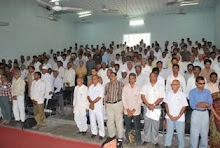The Hindu: New Delhi: Tuesday,
June 14, 2016.
A day after
five private hospitals in the Capital were fined Rs 600 crore for not treating
poor patients, the Delhi government said similar action will be initiated over
the next month against all 43 private hospitals that received land at
concessional rates but failed to provide treatment to poor patients.
‘Robust
accounting’
The quantum
of the fine would depend on the extent to which the hospitals were complying
with or violating the lease conditions, said Dr Tarun Seem, Delhi Health
Secretary. “The court order had directed us to recover the money the exchequer
had lost over the years. The protocol for computing the amount was laid down by
the court and we have a Chartered Accountant who has gone through the
hospitals’ books. The government’s accounting in this case is robust. All
hospitals were given the audits and a hearing after the amount was calculated.
The fine amount is being calculated,” said Dr Seem.
This week’s
directives against allegedly erring hospitals has been nearly two decades in
the making and can be traced to a 1997 Public Interest Litigation (PIL) plea
against a single hospital.
In 1997,
Social Jurist, petitioner in the case that led to the Rs 600 crore fines on
five hospitals, moved court against Indraprastha Apollo Hospital. In 1994, the
hospital had acquired 15 acres of land from the Delhi government on a 30 year
lease, on a monthly rent of Re 1. Over and above this, the Delhi government had
provided Rs 23.83 crore for 26 per cent equity in the hospital and given
another Rs 14.83 crore as compensation for delayed delivery of land.
The lease
obligated the hospital to ensure 33 per cent bed capacity and 40 per cent out
patient (OPD) services for poor patients.
“We went to
court a year after Apollo hospital become operational because almost from the
start, the hospital was not seeing EWS patients. During the pendency of this case,
we identified, through RTI applications and various other means, 43 other such
hospitals. Truth is, even the government does not have an idea at this point,
as to how many hospitals are violating their lease agreements because the DDA
does not follow up and the hospital owners never advertise that they got
subsidised land,” says lawyer Ashok Agarwal, a petitioner in the case and
member of the court-appointed special committee to audit the private hospitals.
A final order in the case, now in Supreme Court, against Indraprastha Apollo
hospital is set for July 12.
Government
mandate
According to
court documents in the Social Jurist Vs GNCT case, as early as June 10, 1949,
the Ministry of Finance and Ministry of Rehabilitation took a decision to,
“allot land on incentivised rates to institutions of secular and non-communal
character to meet the needs of the situation intended to give incentive to all
genuine charitable trusts and institutions to open schools, hospitals, etc.”
Broadly, the decision made land available at subsidised rates for these
institutions. The decision taken by the ministries in 1949 was confirmed by a
Cabinet decision taken on January 17, 1964.
Since 1964,
the Delhi Development Authority (DDA) has been leasing land at subsidised rate
to hospitals, schools and charitable institutions under this law.
“The dam
broke in the 80s when Indira Gandhi’s government approved hospitals to be
privately funded. Since then, across the county, private hospitals have
received land from State governments at concessional rates.”
In Delhi, we
have identified 43 such hospitals where Delhi Development Authority and Land
& Development Office (L&DO) gave concessional land under “Nazul” laws,”
Mr. Agarwal said.
‘Nazul’ land
is land that belongs to the government and includes buildings standing on such
land.
Concessions
misused?
Escorts Heart
Institute & Research Centre (EHIRC) was served with the maximum penalty of
Rs 503 crore. The hospital became functional in 1988 after acquiring land from
the DDA under ‘Nazul’ norms at a concessional rate, on the condition that the
hospital had to be registered under the Societies Act as a non-profit making
institution; reserve 25 per cent beds for EWS patients; another 25 per cent
beds for patients at subsidised costs.














































































